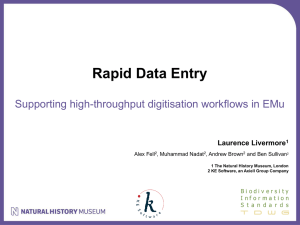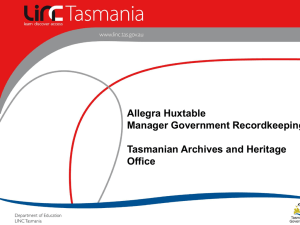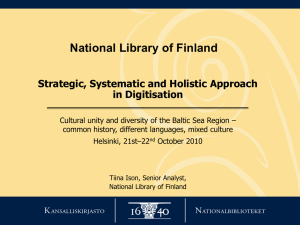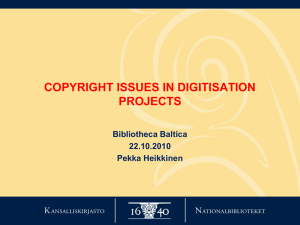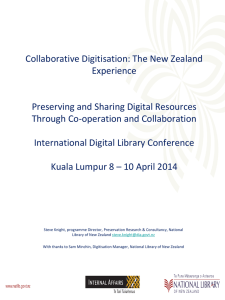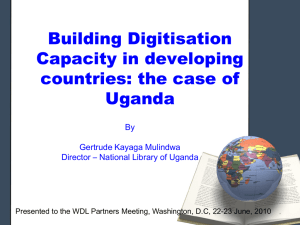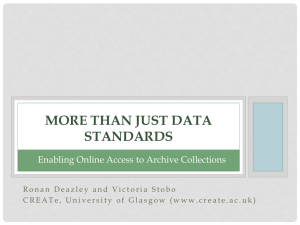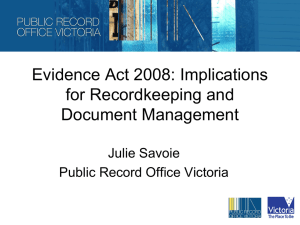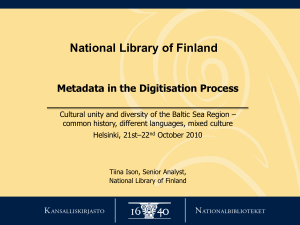Digitisation seminar - Atlas of Living Australia
advertisement
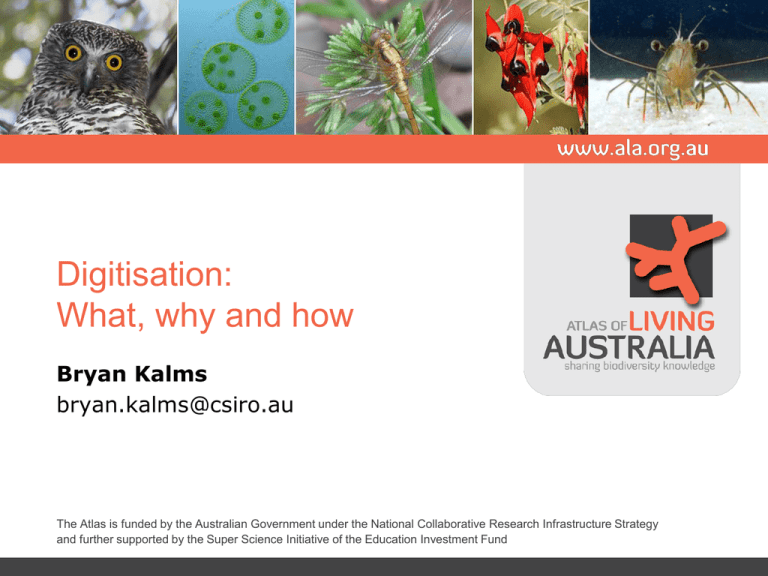
Digitisation: What, why and how Bryan Kalms bryan.kalms@csiro.au The Atlas is funded by the Australian Government under the National Collaborative Research Infrastructure Strategy and further supported by the Super Science Initiative of the Education Investment Fund Topics for today • • • • • • • • Context of the talk Defining digitisation Benefits of digitisation Issues in digitisation Getting started with digitisation Measuring digitisation performance The digitisation landscape Where to from here Context of talk • Curation – Supported through science • Natural history focus – Applies to cultural collections as well • Information and overview – Get you started Digitisation and you What is digitisation? Digitisation is… Moo, moo, moo 111000110010 110110001010 001101110110 111011110101 001100110100 011101100110 010001100010 0000000111 Digital asset What is a digital asset? • • • • • • • • • • Data in a data base Digital image of a collection item Digital image of a painting Digital audio file Digital video file Digital version of a photographic slide Digital version of a microscope slide Scanned (OCR?) version of a field note book Digital CT scan Digital copy of… Core digitisation activities Making digital Databasing Managing data Digitisation Governing digitisation Using technology Sharing data Digitisation process Plan Organise Digitise Manage Share Why digitise? Benefits of digitisation • • • • • • • • • • • • It’s (core) business Reduced object handling Easier loans procedures Easier data sharing Easier compliance with legal obligations Produce more complete data sets Meet client/user needs Create opportunities for better work practices Facilitate new ways of looking at the data Greater audience reach Assist curation process Raise the institution’s profile Issues in digitisation Issues in digitisation • Accepting the need for digitisation • Deciding what to digitise • Knowing your collection • Knowing users and uses • Laying the foundation • Adopting standards • Data management • Funding and resourcing • Managing culture change • Managing data quality • Managing data sensitivities • Feeding the digitisation process • Dealing with rights Issue: Accepting the need for digitisation • Overcome the ‘Why?’ – Sell the benefits • Financial, operational, scientific, practical • Overcome resistance – Curators highly affected – ‘Can’t’ is really ‘It’s hard’ – Show what’s possible • Avoid becoming overwhelmed by the task – It’s all in the strategy – Accept it’s a long term project Issue: Deciding what to digitise • Everything? – Probably not • Selected items? – Strategic? – User driven? – Best contribution to society/science/organisational objectives? – Condition? – …? • Key is to know your: – Collection – Users and uses of digital assets Issue: Knowing your collection • What objects do you have? • What is their condition? • Which are digitised? – – – – Databased? Imaged? How are these digital assets managed? How much time and $$ have you spent making these assets? • Where is your collection going in the future? • What does this mean for digitisation? Object categories, eg… • Documents: monographs, journals, notebooks, ledgers, field notes, photographs, maps • Preserved and dried specimens—individuals • Preserved and dried specimens—groups, drawers • Living specimens • Field work activities • In-situ specimens and • • • • • scenes Analogue images: photographic slides, paintings and drawings, x-ray plates, microfilm, other images, eg CT scans Analogue multimedia Microscope slides Analogue sound files … Issue: Users of digital assets, eg… • Researchers • Natural resource managers • Teachers • Land developers • Students • Consultants • • • • • • Marketers Auditors Citizen scientists Collection managers Policy makers Curators Issue: Uses of digital assets, eg… • • • • • • • • • Education Species identification Policy making Transcription Resource management Entertainment Biodiversity modelling Collection valuation Publication • • • • • • • • Collection management Taxonomy Collection planning In lieu of specimen loans Recordkeeping Online viewing Mapping … Digitisation activities Digitisation processes Digitisation resources (Technology Trained staff Facilities Standards) Digitisation principles Digitisation plans Digitisation strategy Digitisation performance management Digital collections manager Issue: Laying the (ideal) foundation Issue: Adopting standards S A T N R D A D S The good thing about standards is that there are so many of them from which to choose What standards? • Choose a standard – ALA has guidance • Promote the standard within your organisation • Get on with digitisation! Standards-based characteristics for digital assets • • • • • • • Resolution Level of compression Image size Calibration Bit depth Authentication Audio sampling resolution • File format • Encoding format • Interpretation aids, eg colour patches • Preferred access or delivery arrangements Issue: Data management • • • • • • Changing file formats Changing standards Backups Data migration OS changes Software changes Issue: Funding and resourcing • Equipment – Digitisers, IT – Disk storage • • • • • • • • Facilities Updated work practices Expertise People Planning and analysis Digitisation management Research Use of volunteers Issue: Managing culture change • Systematic digitisation requires cultural change • And management leadership – ‘Digitisation is part of our core business’ Issue: Managing data quality • You do have data quality issues, right now – Will be highlighted by digitisation – They are independent of digitisation • They are not an excuse for doing nothing • How will you deal with them? – Come to understand them as you digitise • Use Atlas tools Issue: Managing data sensitivities • You have sensitive data, right now – Independent of digitisation • How will you deal with them? – Digitise and sort it out later • ALA sensitive data service of use Issue: Feeding the digitisation process • Resources needed to provide specimens – Curators highly affected – Planning essential • Integrate into BAU Issue: Dealing with rights • Intellectual property is an issue • Right to information legislation • Capture rights in metadata – Copyright, ownership, moral Getting started with digitisation The systematic way Appoint manager Review Set up working group Collect data Digitise Analyse data Plan Report The practical way Just go for it! Going for it… Digitisation manager Develop strategy/pl an Digitise Review and backfill Going for it… • Have a strategy/plan – – – – – – – Consolidate images, sounds etc Start with a small project Decide naming, storing and backup arrangements Allocate responsibilities Monitor Learn lessons Document everything • Work out your strategy and policy context as you go • The best approach if you are DMM0/1 • Bring the organisation with you Measuring performance Digitisation maturity model We how are building the We all know (next) idea together well we are doing We all know what to do and how it all fits together, and all share the same idea We are getting our act together and starting to Continuous share the same idea innovation by everyone Managers Some of us are take doing a good job No-one has any idea responsibility what's happening fortakes improving Management across the organisation digitisation responsibility for digitisation Digitisation left to each part of the organisation Digitisation left to individuals who have their standard processes Digitisation left to individuals Digitisation maturity model Choose your level Digitisation landscape Digitisation activities • International – NSF spending $US100m – Several European initiatives (Europeana) • Australian – – – – – ALA Accepted in cultural collections Mostly piecemeal in natural history collections Need for digitisation strategies becoming accepted Digitisation becoming expected as part of research grants – Resourcing the main impediment What’s next… …for you? The Atlas of Living Australia Participants The Atlas is funded by the Australian Government under the National Collaborative Research Infrastructure Strategy and further supported by the Super Science Initiative of the Education Investment Fund
